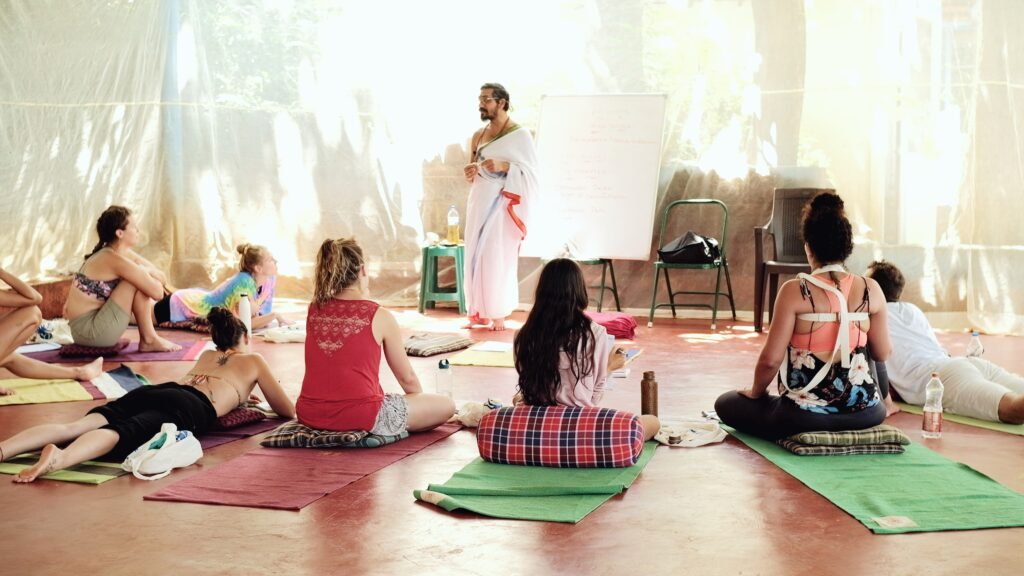
Indian philosophy refers to the philosophical traditions of the Indian subcontinent. It encompasses a wide range of philosophical traditions and practices, including Hinduism, Buddhism, Jainism, and Sikhism, as well as various secular philosophical movements.
Indian philosophy is known for its emphasis on spiritual liberation and the pursuit of self-realization. Many Indian philosophical traditions view the ultimate goal of life as the realization of the true nature of the self and the universe and the attainment of a state of lasting peace and fulfillment.
Indian philosophy is also notable for its emphasis on dharma, which refers to the moral and ethical principles that govern individual conduct and guide the path to spiritual fulfillment.
There are six schools of Indian philosophy, also known as the “orthodox” or “astika” schools. These schools are: Samkhya, Yoga, Nyaya, Vaisheshika, Mimamsa, and Vedanta. Each of these schools has unique philosophical ideas and practices, but they all share a common focus on spiritual liberation and self-realization.
SCHOOLS OF INDIAN PHILOSOPHY:
SAMKHYA
Samkhya is one of the six schools of Indian philosophy, also known as the “orthodox” or “astika” schools. It is a dualist philosophy that posits the existence of two separate and distinct entities: purusha (pure consciousness) and prakriti (matter).
According to Samkhya, purusha is eternal, immutable, and independent, while prakriti constantly changes and is the source of all material phenomena in the universe. The interaction between purusha and prakriti gives rise to the diversity of experiences and phenomena we observe worldwide.
Samkhya emphasizes the importance of self-realization and the attainment of liberation from the cycle of suffering and rebirth. It teaches that the individual self (jiva) is distinct from the universal self (purusha) and that the ultimate goal of life is to realize this distinction and attain a state of lasting peace and fulfillment.
Samkhya also posits the existence of 24 principles or tattvas, which are the universe’s building blocks. These principles include the purusha, prakriti, and 22 other principles derived from the interaction between the two.
Samkhya has significantly influenced other Indian philosophical traditions, particularly Yoga, and is still studied and practiced today.
- Dualism: Samkhya is a dualist philosophy that posits the existence of two separate and distinct entities: purusha (pure consciousness) and prakriti (matter).
- Self-realization: Samkhya emphasizes the importance of self-realization and the attainment of liberation from the cycle of suffering and rebirth. It teaches that the ultimate goal of life is to realize the distinction between the individual self (jiva) and the universal self (purusha) and attain a state of lasting peace and fulfillment.
- Tattvas: Samkhya posits the existence of 24 principles or tattvas, which are the universe’s building blocks. These principles include the purusha, prakriti, and 22 other principles derived from the interaction between the two.
- Karma: Samkhya teaches that the individual’s actions and experiences are determined by their past karma, which is carried over from previous lifetimes. It also teaches that individual has the power to shape their future through their present actions.
- Meditation: Samkhya emphasizes the importance of meditation to cultivate self-awareness and realization. It teaches that through meditation, the individual can gain insight into the true nature of the self and the universe.
- Yoga: Samkhya has significantly influenced the development of Yoga, and the two traditions are often studied and practiced together.
YOGA
Yoga is a spiritual discipline that originated in India and is one of the six schools of Indian philosophy, also known as the “orthodox” or “astika” schools. It involves physical, mental, and spiritual practices that aim to unionize the individual self with the universal self.
According to Yoga philosophy, the ultimate goal of life is to achieve a state of lasting peace and fulfillment, known as moksha or liberation. It teaches that the individual self (jiva) is distinct from the universal self (atman) and that the ultimate goal is to realize this distinction and merge with the universal self.
Yoga emphasizes the importance of self-control and discipline in achieving this goal. It teaches that the individual can achieve liberation through the practice of yoga, which includes physical postures (asanas), breathing techniques (pranayama), and meditation (dhyana).
Yoga also teaches the importance of ethical conduct, known as yamas and niyamas, which guide the individual’s actions and interactions with others.
Yoga has become a popular physical and spiritual practice in various parts of the world and is known for its numerous physical and mental health benefits.
- Physical postures (asanas) involve various body positions that help to improve flexibility, strength, and balance.
- Breathing techniques (pranayama) involve controlled breathing patterns that can help relax the body and mind.
- Meditation and mindfulness: Yoga often incorporates meditation and mindfulness practices that can help to improve focus, clarity, and calmness.
- Relaxation: Yoga can help to reduce stress and improve overall relaxation.
- Spiritual growth: Many people practice yoga as a means of spiritual growth and self-discovery.
- Physical benefits: Regular yoga practice can improve flexibility, strength, and balance, as well as reduce the risk of chronic conditions such as heart disease and high blood pressure.
- Mental benefits: Yoga can help reduce stress, improve mental clarity and focus, and promote well-being.
NYAYA
Nyaya traditional school of Hindu philosophy, founded by the sage Gautama. It developed a complex system of logic and epistemology, which it used to address a wide range of philosophical questions.
Nyaya emphasizes the use of logical reasoning and argumentation to understand the nature of reality and the self. It is based on the Nyaya Sutras, a text that the sage Gautama wrote in the 2nd century BCE.
According to the Nyaya school, the ultimate goal is to achieve liberation from suffering and cycle of rebirths, which can be achieved through acquiring true knowledge. The Nyaya school teaches that this knowledge can be obtained through valid perception, inference, comparison, and testimony.
The Nyaya school also teaches that there are four sources of knowledge, which are:
- Perception: This refers to knowledge that is gained through the senses.
- Inference: This refers to ability that is derived through logical reasoning.
- Comparison: This refers to knowledge that is gained through the comparison of similar objects or events.
- Testimony: This refers to knowledge that is gained through the testimony of reliable sources.
The Nyaya school also emphasizes the concept of causation and teaches that everything exists a cause. It also teaches that there are five eternal substances in the universe: earth, water, fire, air, and space.
VAISHESHIKA
Vaisheshika is one of the six schools of Indian philosophy, along with Samkhya, Yoga, Nyaya, Mimamsa, and Vedanta. It is a naturalistic philosophical system that originated in ancient India and was founded by the sage Kanada. The Vaisheshika school posits nine categories of existence: substances, qualities, actions, generality, particularity, inherence, non-existence, universality, and cognition. The school also emphasizes the concept of atomism, the belief that the behavior and interactions of atoms can explain all physical phenomena. The Vaisheshika school sought to understand the nature of reality and the ultimate nature of consciousness, which significantly influenced the development of Indian philosophy and Hindu thought.
Here are some key features of the Vaisheshika school of Indian philosophy:
- Atomism: The Vaisheshika school posits that the ultimate building blocks of the universe are atoms, which are indivisible and eternal. These atoms combine to form more complex substances, such as molecules, forming the objects and substances that make up the physical world.
- Pluralism: The Vaisheshika school teaches that there are multiple ultimate realities, including atoms and the nine categories of existence. These ultimate realities are said to be independent and self-sufficient, and they are not dependent on anything else for their existence.
- Naturalism: The Vaisheshika school is a naturalistic philosophical system that explains the natural world in terms of natural causes and processes without invoking supernatural or divine explanations.
- Realism: The Vaisheshika school takes a realist approach to the nature of reality, which posits that the objects and substances of the external world exist independently of our perception.
- Dualism: The Vaisheshika school is dualistic in its belief that the mind and body are distinct entities interacting. The mind is seen as a subtle substance, while the body comprises atoms and other physical substances.
- Cause and effect: The Vaisheshika school emphasizes the concept of cause and effect and holds that everything that happens in the world results from some cause or causes.
MIMAMSA
Mimamsa is one of the six schools of Indian philosophy, along with Samkhya, Yoga, Nyaya, Vaisheshika, and Vedanta. It is a philosophical system that focuses on interpreting the Vedas, the ancient Indian scriptures that form the basis of Hinduism. The Mimamsa school developed a system of exegesis and hermeneutics for interpreting the Vedas. It placed great emphasis on performing ritual actions to attain spiritual goals.
Some key features of the Mimamsa school of philosophy include:
- Interpretation of the Vedas: The Mimamsa school is concerned with interpreting and understanding the Vedas, and it has developed a complex system of exegesis and hermeneutics for this purpose.
- Importance of ritual action: The Mimamsa school emphasizes the importance of ritual action as a means of attaining spiritual goals. It teaches that the performance of prescribed rituals can have powerful effects on the individual and the world.
- Belief in the power of words: The Mimamsa school holds that the power of words is central to the effectiveness of ritual action. It teaches that the proper recitation of mantras and other sacred texts can have powerful transformative effects.
- Emphasis on ethics: The Mimamsa school strongly emphasizes ethics and teaches that proper conduct is essential for spiritual growth and fulfillment.
- Naturalism: The Mimamsa school is a naturalistic philosophical system that explains the natural world in terms of natural causes and processes without invoking supernatural or divine explanations.
- Realism: The Mimamsa school takes a realist approach to the nature of reality, positing that the objects and substances of the external world exist independently of our perception of them.
VEDANTA
Vedanta is concerned with the ultimate nature of reality and the self. It is based on teachings of the Vedas, the oldest and most sacred scriptures of Hinduism, and often referred to as the “crown jewel” of the Vedas.
Some key features of Vedanta philosophy include:
- Brahman: This is the ultimate reality, which is seen as a single, all-pervading consciousness that is the source and substance of everything that exists.
- Atman: This is the individual self or soul, which is seen as a spark of the divine temporarily encased in the body.
- Maya: This illusion or ignorance prevents individuals from realizing their true nature as Atman and leads to suffering and the cycle of rebirth.
- Karma: This is the law of cause and effect, that states that every action has consequences that determine the circumstances of future lives.
- Moksha: This is the ultimate goal of Vedanta philosophy, which is the realization of the identity of Atman and Brahman, and the resulting liberation from suffering and the cycle of rebirth.
